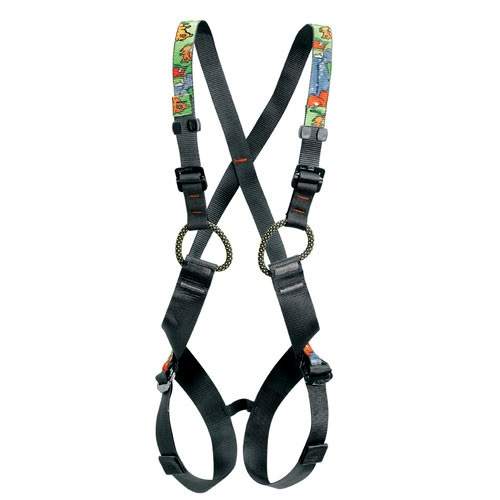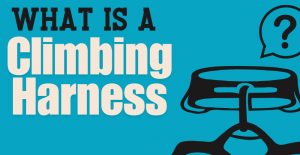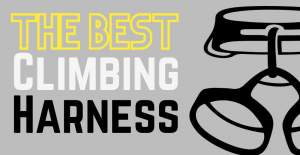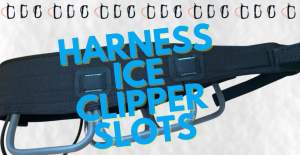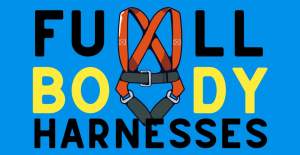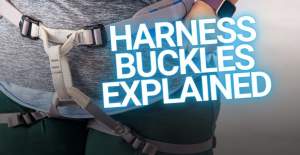Describes with words and helpful photos, how to protect your harness.
Simba
Description
Because small children do not have well-defined hips for a waistbelt to latch onto, the full body design is necessary for safety.
For children from 5 to 10 years old weighing less than 40 kg
Fully adjustable shoulder straps and leg loops for precise fit
Bicolor webbing (black inside, colored outside) facilitates donning
Four DoubleBack adjustment buckles
Retail price
This Product is Hard to Find.
We don’t know where you can buy this item online in the US. We’ll continue to check all the major retailers and will update this page as soon as we find one.
If you know where to find this online in the US, let us know, and we’ll add the link.
Weight (g)  WeightIn grams, the weight, as stated by the manufacturer/brand. If there are differences in weight (due to multiple sizes or optional accessories) we'll list them here. The default weight is the middle-most size, often this is size M. | 390 g One Size : 390 g / 13.8 oz |
| Fit | Kids - Full Body |
| Sizes | 1 Size Fits All |
Gear Loops  Number of Gear LoopsGear loops are used to hold gear (quickdraws, cams, etc) onto your harness. 4 gear loops is most common. 
0 - 1 Gear LoopsMost often on full body harnesses or guide/gym style harnesses. 2-3 Gear LoopsMostly found on lighter harnesses made for [ski] mountaineering or high-end sport climbing where weight is a high priority. 4 - 5 Gear LoopsThe standard/most common number for climbing harnesses. Perfect for sport and trad. More Than 6 Gear LoopsDesigned for long multi-pitch and big wall climbing, found on harnesses made to hold the maximum amount of gear. Worth ConsideringOccasionally, the number of gear loops will change on a harness model depending on the size. There could be 7 gear loops for the med/large but only 5 gear loops for the xsmall/small. In this case we list the highest number for the filters, and then write an explanation on the product page like, “Size S/XS can only fit 5 gear loops.” | 0 Gear loops |
Ice Clip Slots  Ice Clip SlotIce clipper slots are made to fit a carabiner that holds ice screws. These slots are generally only used by ice climbers but there is no disadvantage to having them on your harness. 
Less than 40% of harnesses will have ice clipper slots. And those harnesses will usually have 2 or 4 slots, often located next to, or between, the gear loops. | No, 0 |
| Belay / Tie-In | Tie-In |
| Waist Buckle Type | |
| Leg Buckle Type | Manual Doubleback |
| Drop Seat | No |
Haul Loop  Haul LoopTrad climbers often look for a haul loop as they're intended to haul a rope (second line) or pack (while you climb the chimney). 
A haul loop can also hold shoes or other accessories. Although not the intended use, it is also commonly used to hold a chalk bag. | No (0kN) |
| Certification | CE, UIAA |
| Size Chart | One Size |
No reviews yet.
If you want a versatile harness to do basic tasks such as top roping at the gym or high ropes courses at camp, the Simba is a tested, tried and true harness that won't disappoint. This is one of the most popular children's harnesses and for a good reason. Petzl has a history producing some of the best climbing gear available; this is no exception.
Warning: This video is dubbed in English. If you're getting antsy, skip to section 7:40-8:15 for one of the most interesting parts, where they show a hardware specific camera inspection.
A checklist helping you monitor your harness health, helping to know when to retire your harness.
Helpful instruction for inspecting Petzl harnesses.
How to correctly use Petzl harness, inspection, donning and setup with instructional pictures.
Describes with words and helpful photos, how to protect your harness.
How to use Petzl Harness, warnings, lifetime with instructional pictures
A pictoral representation of UIAA-105 and EN-12277 standards for harnesses.
The UIAA equipment standard provides a baseline for equipment performance in a test lab under controlled conditions on new equipment. Although these test conditions are relevant to the conditions encountered climbing, conditions encountered at the crags and the condition of the equipment are equally important. This recommendation from the UIAA member federation The British Mountaineering Council (BMC) provides vital equipment information that is NOT explicitly addressed in the standard, particularly failure modes of the equipment and recommendations for the use, inspection, maintenance, and retirement of equipment.
How to use Petzl Simba, inspection and when to retire with instructional pictures.

